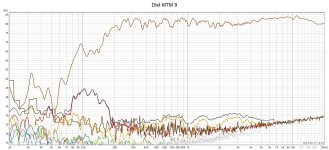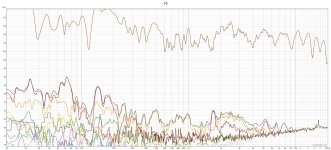In my listening room I got best results with 1 woofer when positioned in the corner with the membrane close to the wall. But a multi sub setup was even better and more even through the room/listening zone.Anyone have any feeling towards or against using a room corner for boost and FR of a sub?
Do you know the Harman multi sub paper? (multisubs_0.pdf). That's the conclusion of best positions:
This are just 4 subs playing, no delay etc. I also have good experience with the positioning for 2 subs.
Also pretty good (place 4 or 5) was subs at the position where they would be with a double array - 1/4 in from L/R and 1/2 room height.
So while you can get good results with one sub it's more consistent with more subs.
But next level is a double bass array where you can influence room acoustics! (Dirac ART should also do the trick)
Hi @IamJF. According to my recollection, 1/4 spacing from corners was the best performing position out of all the configurations in that study.. Being 1/2 distance between the ceiling, and the floor was not a part of the conditions, as I recall it.Also pretty good (place 4 or 5) was subs at the position where they would be with a double array - 1/4 in from L/R and 1/2 room height.
I missed your question Camplo!Have you measured distortion at peak spl?
It was a long time ago & I have 1000s of different measurements on the computer (poorly organized), but found 2 early measurements.
One at normal volume without woofers & 1 with high volume where the microphone was at the listening position about 3.9 m from the speakers.
These measurements were at the beginning before the xovers were adjusted.
But making measurements is really a skill, and these was my first 6 month of learning measurements, think im better at it now 3 years later 👍
regards John
Attachments
Thanks for sharing, can you show the Group Delay corresponding to those?One at normal volume without woofers & 1 with high volume where the microphone was at the listening position about 3.9 m from the speakers.
Last edited:
It looks like the subs really add up in efficiency but what is catching my eye is how Dynamic the Tweeter is for a non compression driver.
Dynamic range looks like big enough for the room, quickest way to deafness, if you regularly listen to that. 😉
👍
👍
That things a beastMundorf AMT29CM1.1
AMT were my favorite until I can here and they showed me the power of the horn loaded compression driver. This ribbon competes with a compression driver, not winning on dynamics but winning on FR. As I said before the most potent factor of Accuracy given everything else is good, is Directivity. I think I would want a big waveguide on my AMT tweeter.
Last edited:
I personally would not, but I take measurements at peak spl levels to see the potential accuracy of transients that asre living 15db above RMS. 95db average is plenty loud, and even that is only safe for only segmented periods. The movies take advantage of that, I see peaks of 120db or better (at the movies) on the regular and thats on a C scale..quickest way to deafness, if you regularly listen to that
Yes, it´s unbelievable good.That things a beast
But expensive!
I reasoned that instead of regularly buying new "semi-expensive" drivers and trying them out, I aimed high right away just because that "tweeter" can be used low & can handle a lot of power.
How do i do that?Thanks for sharing, can you show the Group Delay corresponding to those?
I use REW and Umik mic
It´s so much to learn for my old foggy brain
Here i must disagree. (but know what you mean in general)Dynamic range looks like big enough for the room, quickest way to deafness, if you regularly listen to that. 😉
👍
Had many different stereo setups in my life, and have listening on so many in total with friends, in stores & at hifi fairs.
It´s all about distortion!
You can have a little distortion, BUT it have to be THE right one, on the right places!
Im supersensitive about "wrong" distortion, and my ears and head can´t stand 10 secunds of it.
Hard to explain, but when you "get there" you know.
Had many people listening on my "big system" over the last 4 years, and they don´t realize that im playing 110 dB.
When they get home, they realize.. it is clear that sustained listening to 110dB will be a risk to your hearing, distorted or not.they don´t realize that im playing 110 dB.
Don´t agree on that.When they get home, they realize.. it is clear that sustained listening to 110dB will be a risk to your hearing, distorted or not.
You talking about coming home from a consert.
That is fine with me, they are your ears. But there is a reason why there are safety norms for concerts, and it is lower than 110dB. Also in noisy working environments there are loudness norms. 80dB is about the limit for 8 hours of continuous exposure before hearing damage occur, at least in my country. In many professions it is obligatory to wear ear protection. Thirty dB louder is 8 times the loudness of 80dB. Every 10dB more means twice as loud. Many classical big orchestra musicians have hearing damage after many years of playing music and live classical music has no "distortion". So suggesting that 110dB exposure for sustained periods can do no harm when the audio system has little distortion, is a dangerous one. But do what you want with your and your friends ears, no problem with me.Don´t agree on that.
Do you for real only think it´s about the dB?That is fine with me, they are your ears. But there is a reason why there are safety norms for concerts, and it is lower than 110dB. Also in noisy working environments there are loudness norms. 80dB is about the limit for 8 hours of continuous exposure before hearing damage occur, at least in my country. In many professions it is obligatory to wear ear protection. Thirty dB louder is 8 times the loudness of 80dB. Every 10dB more means twice as loud. Many classical big orchestra musicians have hearing damage after many years of playing music and live classical music has no "distortion". So suggesting that 110dB exposure for sustained periods can do no harm when the audio system has little distortion, is a dangerous one. But do what you want with your and your friends ears, no problem with me.
Big orchestra musicians have lots of distortion all around them.
Govrements can´t set 1000 of different rules on the safety norms, so thats why they set a safe dB role/law
And they also must have a standard to use, so dB was selected.
So evev if it´s 20 % or 0,2% distortion, "the rule/law lay´s" in the SPL because it´s the same for all the world.
I put my left arm on, that 80 dB can be much worse for you hearing than 100 dB
Distortion is just another sound that add to a certain SPL. Distortion is how our brain interprets it, our ears don't care. I guess governments apply rules on safety norms, because science has figured it out that sustained exposure to loud sounds can lead to hearing damage. Sometimes, with distortion, sounds seem to sound much louder than it really is, and vice versa very clean sound can sound less loud than it really is. I'll rest my case and undeniably, your system is a great system that can play very loud effortlessly and clean, nice build. I also have a clean system (not so nice build tho) that could play very loud (BMS 4592ND at 3m could take your eardrums out in a minute) but coupled to a flea amp it saves my hearing 🙂
- Home
- Loudspeakers
- Multi-Way
- Is it possible to cover the whole spectrum, high SPL, low distortion with a 2-way?

